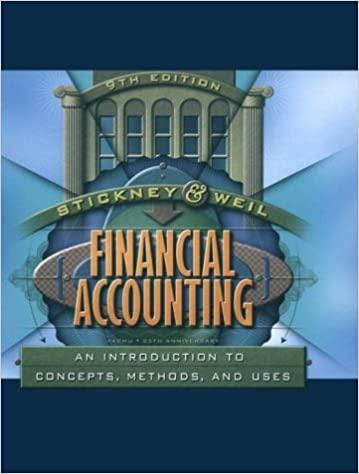Year 11. Pins Company carried out an aging of its accounts re- ceivable balances and estimated that
Question:
Year 11. Pins Company carried out an aging of its accounts re- ceivable balances and estimated that the Year 11 ending balance of accounts receiv- able contained $11.000 of probable uncollectibles. That is, the allowance account should have an $11.000 ending credit balance. It made adjusting entries appropriate for this estimate. Some of the $800,000 sales during Year 11 were for cash and some were on account; we purposefully do not give the amounts.
a. What was the balance in the Accounts Receivable (gross) account at the end of Year JO? Give the amount and whether it was a debit or a credit.
b. What was the balance in the Allowance for Uncollectible Accounts account at the end of Year 10? Give the amount and whether it was a debit or a credit.
c. What was bad debt expense for Year 1 1 ?
d. What was the amount of specific accounts receivable written off as being uncollectible during Year 11?
e. What were total cash collections in Year II from customers (for cash sales and collections from customers who had purchased on account in either Year \() or Year 11)?
f. What was the net balance of accounts receivable included in the balance sheet asset total for December 31. Year II?
28. Decision to extend credit to a new class of customers. The Nordstrom Department Store near the University of Washington campus has a gross margin on credit sales of 30 percent: that is. cost of goods sold on account is 70 percent of sales on account.
Uncollectible accounts amount to 2 percent of credit sales. If the firm e.xtends credit to a group of new student customers, credit sales will increase by $10,000, 7 percent of the new credit sales will be uncollectible, and all other costs, including interest to finance extra inventories, will increase by $1,100.
a. Would Nordstrom be better or worse off if it extended credit to the new class of customers, and by how much?
b. How would your answer to part a differ if $3,000 of the $10,000 increase in credit sales had been made anyway as sales for cash? (Assume that the uncollectible amount on new credit sales is $800 and the new credit sales alone generate $750 of "'all other costs."")
29. Decision to extend credit: working baclvward to uncollectible rate. Hanrahan Company has credit sales of $250,000 and a gross margin on those sales of 20 percent, with 2 percent of the credit sales uncollectible. If the fimi extends credit to a new class of customers, credit sales will increase by $20,000, other expenses will increase by $300. and uncollectibles will be 3 percent of all credit sales. Verify that Hanrahan Company will be $600 better off if it extends credit to the new customers.
What percentage of the new credit sales is uncollectible?
30. Effect of errors involving accounts receivable on flnancial statement ratios. Indicate—
using 0/S (overstated), U/S (understated), or NO (no effect)—the pre-tax effect of each of the following errors on ( 1 ) the rate of return on assets, (2) the cash flow from operations to average current liabilities ratio, and (3) the debt equity ratio.
Each of these ratios is less than 100 percent before discovering the error.
a. A firm using the allowance method neglected to provide for estimated uncollectible accounts at the end of the year.
b. A firm using the allowance method neglected to write off specific accounts as uncollectible at the end of the year.
C. A firm credited a check received from a customer to Advances from Customers even though the customer was paying for purchases previously made on account.
31. Income recognition for a nuclear generator manufacturer. General Electric Company agreed on June 15. Year 2. tt) construct a nuclear generator for Consolidated Edison Company. The contract price of $200 million is to be paid as follows: at the time of signing. $20 million: on December 31. Year 3. $100 million: and at completion on June 30, Year 4, $80 million. General Electric Company incurred the following costs in constructing the generator: Year 2, $42 million; Year 3, $54 million; and Year 4. $24 million. Those amounts conformed to original expectations.
a. Calculate the amount of revenue, expense, and net income for Year 2, Year 3, and Year 4 under each of the following revenue recognition methods:
(1) Percentage-of-completion method (2) Completed contract method (3) Installment method (4) Cost-recovery-first method
b. Which method do you believe provides the best measure of General Electric Company's performance under the contract? Why?
Step by Step Answer:

Financial Accounting An Introduction To Concepts Methods And Uses
ISBN: 9780030259623
9th Edition
Authors: Clyde P. Stickney, Roman L. Weil





